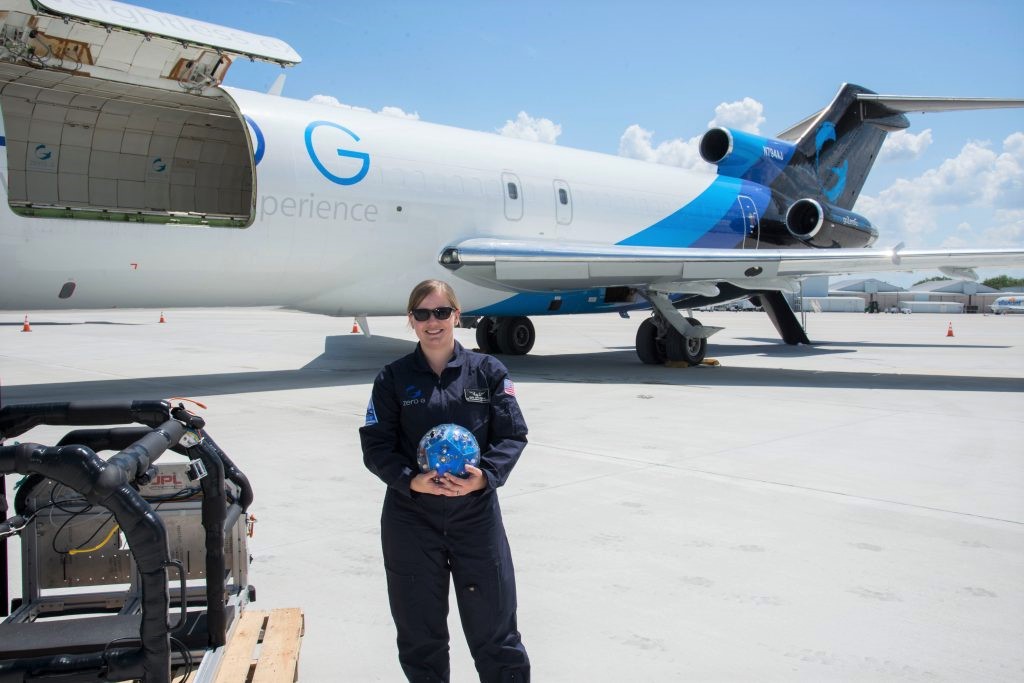
In 2024 or 2025, the National Aeronautics and Space Administration – better known to many Americans by the acronym NASA – plans to launch the Europa Clipper, an unmanned spacecraft, toward Europa, one of Jupiter’s moons. NASA’s scientists hope to determine if the moon possesses the conditions needed for supporting life.
Laura Jones-Wilson ’07 is a key player on that mission. She has been working on the project in various capacities at NASA’s Jet Propulsion Laboratory in Pasadena, Calif., for the better part of six years. So, to her, three more revolutions around the sun basically equates to roughly a 20-minute wait at the dentist’s office.
“People had been working to get a funded Europa mission together for decades,” she said. “I’ve been on the project for six years. I started on this mission when they announced the instrument selection six years ago. So, after all this time, I’m getting excited to finally see hardware being built. Things are really heating up.”
Jones-Wilson, who received her undergraduate degree from Virginia Tech’s Kevin T. Crofton Department of Aerospace and Ocean Engineering, currently serves as the payload verification and validation lead for the mission. Her role is of utmost importance. In simple terms, she oversees the analysis and testing of the spacecraft’s instruments, which hopefully will provide scientists with the information needed to determine the habitability of the moon.
Scientists believe Europa holds the three ingredients needed for life: water, the right chemical elements, and energy. Icy satellites of the outer solar system intrinsically have a lot of water, and they believe that Europa has a salty ocean underneath its cold, icy crust. Europa’s ocean may contain more water than all of the Earth’s oceans combined.
But scientists need more data to prove their hypotheses, and the Clipper’s instruments are designed to provide just that. The Clipper possesses a suite of 10 instruments — everything from ice-penetrating radar to cameras and spectrometers capable of creating high-resolution images and composition maps of the moon’s surface to a dust analyzer and mass spectrometer to study dust particles in space near the moon. A radiation vault protects most of the electronics from Jupiter’s radiation.
“We’re sending the spacecraft out there, and all of those instruments are going to return data that we’ll use to assess Europa’s habitability,” Jones-Wilson said. “My job is to make sure those instruments work properly. So, we have a rigorous analysis and testing program to make sure that we know before we launch that they can all actually answer the science questions that we’re sending them there to investigate.”
The 13,000-pound Clipper will travel 484 million miles and can take up to six years to get to Europa. Once in Jupiter’s orbit, the Clipper will spend a year altering its trajectory for its Europa flyby and then spend the next three years orbiting Europa more than 40 times. The data collected during each flyby gets sent back to Earth.
So, this is arguably one of NASA’s most ambitious missions, and Jones-Wilson plays a critical role.
“As soon as I came to the Jet Propulsion Laboratory, I knew that Clipper was the project I wanted to work on for a while because it’s a new front in understanding our solar system that is my generation’s version of the early Mars program,” Jones-Wilson said.
Jones-Wilson finds herself in a role that she has wanted since attending an Earth Day celebration as a 5-year-old and learning about space. A few years later, she learned the word “engineer” from watching “Star Trek” episodes, and that only motivated her more to pursue a career related to space.
Virginia Tech certainly played an important role in preparing her for this career. The school’s highly acclaimed aerospace engineering program had an usually large offering of dedicated coursework on spacecraft engineering (rather than general aerospace engineering) that appealed to her coming out of high school in Alexandria, Va., and she liked the research being done at Virginia Tech. The department’s professors — particularly Chris Hall, a former Virginia Tech department head who now works at the University of New Mexico — allow undergraduates to work with graduate students in research labs, which also appealed to her.
An honors student, Jones-Wilson earned a degree in aerospace engineering with a minor in mathematics. Hall, who was Jones-Wilson’s advisor at the time, changed her life when he insisted that she apply for fellowships to go to graduate school.
Jones-Wilson won two fellowships that paid for her to earn her master’s and doctoral degrees at Cornell University.
“I like to say that I owe him $500,000,” Jones-Wilson said. “I don’t think I would have had the self-confidence to apply for those fellowships if Chris hadn’t told me, ‘No, you have to do this.’”
After she defended her dissertation, she joined NASA’s Jet Propulsion Laboratory weeks later as a guidance control expert and gradually worked her way into her current role as the payload verification and validation lead for Europa Clipper.
The launching of the Europa Clipper in a little more than three years will result in her moving to a different project after spending so many years and so much energy on this one. “There will be no dearth of really cool missions to transition on to,” she said. “Generally speaking, NASA doesn’t rest on its laurels. It’s trying more ambitious things, and there are always new challenges to try out.
“I’m going to be happy no matter where I end up.”


